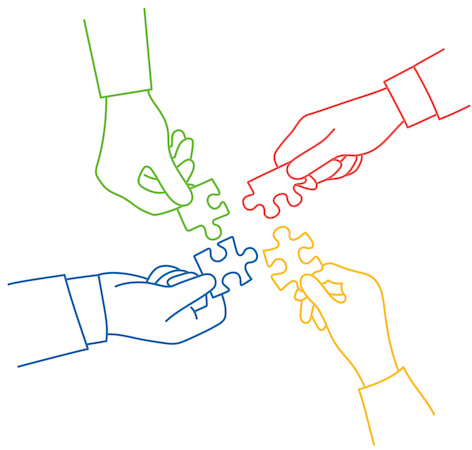Team Work

As you’ve seen, the group project will constitute a large portion of this class. And this isn’t just in terms of formal assignment submissions: the group project is a jigsaw puzzle: each piece you put together gives you a better idea of where you’re headed, and you need to put all of the pieces together to see the whole picture.
Throughout the class, you will often find yourself presenting on and discussing your progress on the group project, both working with your own group and consulting with other groups. In fact, most of the coursework will be closely tied to the group project, which will require good teamwork. You may not like group projects. Still, there are at least two reasons—one pedagogical, and one professional—for having them.
First, the discussion and negotiation that occurs in teams will support your learning. The more you discuss your view and the views of your fellow group members, and the more you challenge them, the better you will come to understand them. Not only that, but building social computing systems is about skill and technique just as it is about knowledge. Getting the chance to apply what we discuss in class is vital to learning it. By the end of the course, each group will have built and evaluated a functioning social computing system prototype. Second, teams are a common feature of the workplace, in virtually every industry, and HCI, UX, and Software Engineering are no exception.
Many of you will have been, or currently are, involved in work teams, either formally or informally. In both face-to-face and remote contexts, team members have to practice good communication and collaboration. Job descriptions routinely ask for these skills, and I hope this class will help you to develop and reflect on these skills. (E.g., on a job interview, you might be asked about a successful, or perhaps failed, group project.) All team members should take part in all project activities, although responsibilities may be divided so that different members take the lead in different activities. No activity should be done exclusively by a single person. While the volume of work of each group member on each project component may not be equal, their contribution to the overall project should even out. You will need to meet with your group multiple times a week, whether that’s face to face or online (video chat, Microsoft Teams, Slack, WhatsApp, etc.).
Here are some suggestions for achieving good teamwork:
- Select what technologies you’ll use for communication and work as early as possible.
- Choose a team leader. (Note: team leader ≠ dictator)
- Discuss your individual skills and strengths (graphics, programming, writing, etc.) and see where each of you can best contribute.
- Notify each other as soon as possible of travel, illness, schedule conflicts (including other class assignments), etc.
- Explain what you mean, and say why you’re saying it.
- Be proactive: don’t just do “what I was told,” but also actively look for ways you might contribute that everyone else has overlooked.
- Set agendas and time limits for your meetings. It may be a good idea to begin each group meeting with a brief report from each member on their progress.
- Make every effort to ensure that all team members feel comfortable about other members’ contributions. Be open about grievances.
- Feel free to use me as a scapegoat: “Dr. V will not find this convincing. Why don’t we try…?”
- General policy: if ever in doubt, communicate! Redundancy is okay. Repetition is good. Keep everyone in the loop. If your team is not functioning well, this could negatively impact your learning. If you find you cannot resolve the issue on your own, let me know and I will offer some help.